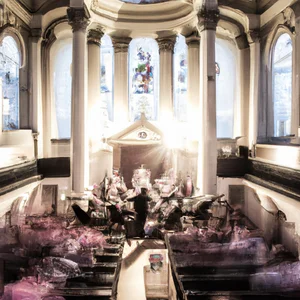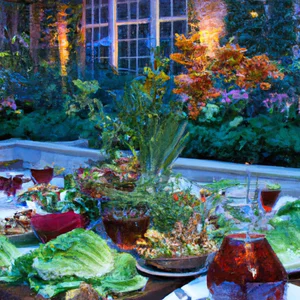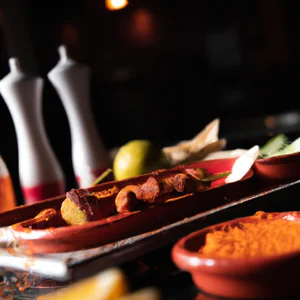Book your experience
French pastry shops in London: croissants and macarons in the British capital
So, let’s talk a bit about French patisseries in London, which are truly a must, I tell you! If you are in the city and are looking for a good croissant or maybe those delicious macarons, well, you can’t miss these gems.
Imagine walking down one of Soho’s busy streets, with the smell of fresh butter guiding you like a GPS. I assure you, the first bite of a hot croissant is like a treat for the palate! And let’s not talk about macarons, those colorful sweets that almost look like works of art. I think every time I get one, I feel a bit like an artist looking for my muse.
There are so many pastry shops, each with their own style. There’s that little shop in Covent Garden, where the owner, a French lady called Marie, churns out croissants as if they were her labors of love. And you know, every time I go there, there’s always someone who chats with me, as if we were old friends. That’s what makes it even more special, right?
And then, I noticed that there are also places that try to reinvent tradition, mixing local ingredients with French recipes. I’m not sure if they always work, but it’s interesting to see how Londoners try to put their own twist on these classics. Sometimes, maybe the result is a little strange – the other day I tasted an Earl Gray tea macaron, and I tell you, it was a journey of flavours!
In short, if you are in London and want to have a sweet break, do yourself a favor and look for one of these patisseries. Whether it’s for a quick croissant or a snack with macarons, you won’t be disappointed. And who knows, maybe you too will find your corner of paradise in this urban jungle!
The best croissants in London: where to find them
An awakening with the scent of butter
I still remember my first morning in London, when the sun timidly peeked out over the rooftops and the scent of fresh croissants invaded the streets of South Kensington. Upon entering one of the local bakeries, I was greeted by an explosion of aromas: melting butter, the sweet fragrance of freshly baked pastries. The croissant I savored that day was a perfect balance of crunchiness and softness, a journey of flavors that made me feel like I was in Paris, but with a hint of that British character that makes London so unique.
Where to find the best croissants
If you want to immerse yourself in this delight, there are some pastry shops that you absolutely cannot miss:
-Dominique Ansel Bakery: Famous for her Cronut, but the croissants here are equally divine. Made with high-quality French butter, they are light and flaky, perfect for enjoying with a cup of coffee.
- Pierre Hermé: Located in the heart of Covent Garden, this patisserie is a true temple of French pastry making. Their butter croissants are a must, and I recommend you try them with one of their artisanal jams.
- La Pâtisserie des Rêves: This patisserie is known for its elegant aesthetic, but don’t underestimate their croissants, which are among the best in the city. Also try their famous Paris-Brest for the complete experience.
An insider tip
A little-known secret is that many of London’s best croissants are baked early in the morning, so arriving before 9am is a surefire way to ensure you find the fresh produce. Some patisseries also offer takeaway pastries, allowing you to bring a piece of France to a London park.
The cultural impact of croissants in London
The croissant’s arrival in London dates back centuries, but it has become a symbol of French culinary culture in the city. With the growing popularity of French cuisine and international influences, croissants have also found their dimension in the British capital. This sweet tradition has helped shape London’s food scene, making the city a crossroads of culinary cultures.
Sustainability in pastry making
Many of London’s most renowned patisseries are committing to more sustainable practices. They use local, seasonal ingredients and work to reduce waste, which not only makes their desserts fresher, but also makes them more environmentally responsible. Choosing patisseries that adopt sustainable practices is a great way to support responsible tourism.
An experience not to be missed
I recommend you take part in a croissant making class at one of London’s cooking schools. Not only will you have the opportunity to learn the secrets of pastry making, but you will also be able to enjoy your own freshly baked croissants, an experience that will leave you with a sweet and unforgettable memory.
Myths to dispel
One of the most common myths is that croissants must always be filled with chocolate or jam to be considered delicious. In reality, a classic butter croissant, simple and well made, can offer you a taste experience that surpasses any filling.
Reflecting on the sweetness of London
Next time you’re in London, take the time to enjoy a croissant from one of these amazing patisseries. Who knows, you might find your heart split between two culinary capitals. What is your favorite croissant and what story lies behind your love for this dessert?
Artisan macarons: a journey of flavors
An unexpected encounter
I still remember my first bite of an artisanal macaron. It was a spring morning in London, and I was in a small café in South Kensington, surrounded by an atmosphere that smelled of sweets and coffee. The macaron I chose, a delicate lavender-colored flavored with lavender and honey, melted in my mouth, revealing a balance of flavors that immediately took me to a flower garden. This meeting marked the start of an odyssey to discover the best artisan macarons London has to offer.
Where to find the best macarons
London is a true paradise for macaron lovers. Some of the must-see places include:
- Pierre Hermé: With his shop in Harrods, he offers a variety of flavours, from classic ones to innovative combinations such as chocolate and pepper pink.
- Ladurée: Iconic for its elegance, the Covent Garden café is famous for its colorful macarons, a true symbol of Parisian sweetness.
- Konditor & Cook: This pastry shop offers fresh macarons and a selection of seasonal flavors that will surprise even the most demanding palates.
A secret tip
If you want to discover a unique taste, look for coffee macarons. It is not just a dessert, but an experience that combines sweetness with the depth of coffee, creating a perfect contrast. Many pastry shops in London offer this combination, but only a few execute it with skill.
A sweet cultural heritage
Macarons, originally from France, have found a new home in London, where they have evolved and adapted to local tastes. This dessert is not only a symbol of French pastry making, but also represents the dialogue between different cultures, with London pastry chefs reinterpreting traditional recipes. The popularity of macarons has helped grow an artisanal dessert culture, where quality and creativity take center stage.
Sustainability and macarons
Many London pastry chefs are committing to using local and organic ingredients, thus reducing the environmental impact of their production. Opting for macarons made with sustainable ingredients not only pays homage to the environment, but also offers a more authentic and rich flavour.
Soak up the atmosphere
Imagine sitting in a crowded bakery, with the sweet scent of fresh macarons filling the air. The light softly reflects on the pastel colors of the sweets on display, while the sound of conversations mixes with the clinking of tea cups. Every bite is a journey, and every macaron tells a story.
An experience worth trying
To experience this experience first hand, take part in a pastry making workshop, where you can learn to create your own macarons. Many places in London offer hands-on courses, where an expert pastry chef will guide you through the preparation process, from choosing the ingredients to the final decoration.
Myths to dispel
A common misconception is that macarons are too difficult to make. In reality, with a little patience and attention to detail, anyone can try their hand at this confectionery art. Don’t be put off by appearances: the secret lies in practice and the choice of quality ingredients.
A final reflection
The next time you taste a macaron, ask yourself: what story lies behind that colorful dessert? Every bite is a journey not only in flavours, but also in culture and tradition. Are you ready to discover the secrets of this iconic dessert?
Historic pastry shops: a dive into the past
A journey through time through desserts
Imagine entering a historic patisserie in London, where the air is filled with the aroma of fresh butter and icing sugar. The first time I crossed the threshold of G. Leverton & Sons, an 1852 Camden icon, I felt transported to another era. Every corner of that place told stories of culinary traditions, and the counter, full of sweets, was a sort of edible museum. Here, I tasted a Victoria sponge which, with its lightness and the sweetness of the strawberry jam, made the strings of my memory vibrate.
Where to find historical gems
If you want to explore London’s historic patisseries, don’t miss Savoury & Sweet in Chelsea, which has been serving pastries and cakes made from recipes passed down from generation to generation since 1875. Another unmissable stop is Baker & Spice, where even the smallest desserts reflect the art of traditional pastry making.
An insider tip
Here’s a little-known tip: many of these historic shops offer pastry-making courses. Taking part in one of these workshops will not only allow you to learn the secrets of classic recipes, but will also give you the opportunity to interact with master pastry chefs, who are often passionate custodians of local traditions.
A significant cultural impact
London’s historic patisseries aren’t just dessert places; they are custodians of a culture that has evolved over the centuries. The pastry shop played a fundamental role in daily life, acting as a meeting point for families and their stories. These historic spaces are a reflection of the culinary innovations that have influenced British gastronomy, from the famous Victoria sponge to the Bakewell tart.
Sustainability and tradition
In an age where sustainability is key, many of these historic bakeries are adopting responsible manufacturing practices, such as using local and organic ingredients. This not only preserves culinary traditions, but also supports the local economy and reduces environmental impact.
An experience not to be missed
For an authentic experience, book afternoon tea in one of the historic patisseries, accompanied by a selection of fresh pastries. There’s nothing better than enjoying a freshly baked scone, with cream and jam, while listening to the fascinating stories that permeate the place.
Dispelling the myths
A common misconception is that historic pastry shops only offer traditional desserts. In fact, many of these places are reinventing their recipes, incorporating modern influences and exotic ingredients to attract a new generation of customers.
A final reflection
As you let yourself be enveloped by the scents and flavors of London’s historic patisseries, ask yourself: how can the culinary traditions of the past influence the way we live and eat today? This is an opportunity not only to delight the palate, but also to reflect on the importance of culture and history in our daily lives.
Discover the boulangerie: an authentic experience
A journey through the flavors of London
I still remember my first visit to a boulangerie in London. It was a crisp autumn morning and the air was filled with the inviting aroma of freshly baked bread. Upon entering, I was greeted by a counter of pastries and bread that looked like something out of a dream. The owner, a Frenchwoman named Marie, smiled at me as she served me a warm, buttery croissant. * “The key is the butter,” * she said, * “and patience.” From that moment, I understood that it was not just about food, but about an experience that combined culture and tradition.
Practical information
London’s boulangeries are gaining popularity and are becoming more and more widespread. Some of the best places to enjoy an authentic baguette or croissant are:
- La Parisienne: Located in South Kensington, offering a selection of homemade baked goods with fresh, high-quality ingredients.
- Pâtisserie des Rêves: This boulangerie is famous for its innovative desserts, but don’t forget to try their bread, which is a real delight.
- Le Pain Quotidien: With several locations throughout the city, it is a chain that maintains the authenticity of the boulangerie with traditional recipes and organic ingredients.
An insider tip
A little-known tip is to always ask what the specials of the day are. Many boulangeries offer seasonal variations of their products, such as croissants filled with chestnut cream in autumn or sweet bread with red fruits in summer. These options can provide a unique and surprising gastronomic experience.
Cultural and historical impact
Boulangeries aren’t just places to buy bread; they are places of meeting and socialization. In France, the boulangerie is an institution, and this tradition is also reflected in London, where locals stop for a coffee and cake, creating a community around their bakeries. The presence of boulangerie in London tells of a French cultural imprint that has influenced British cuisine, bringing a touch of refinement and style.
Sustainability in pastry making
Many boulangeries in London have committed to operating sustainably. They use local and organic ingredients, reduce waste and often offer vegan options. Choosing to purchase from these boulangerie not only satisfies the palate, but also supports responsible practices.
An activity worth trying
For an unforgettable experience, attend a baking workshop at a local boulangerie. You will learn the secrets of the trade while immersing yourself in the scent of flour and yeast. It’s a perfect way to better appreciate the work that goes into every bite of a croissant.
Myths to dispel
A common misconception is that all boulangerie are the same. In reality, each boulangerie has its own philosophy, techniques and unique recipes. Many also believe that croissants should always be sweet, but there are savory variations worth exploring.
Final reflection
As you savor a crunchy, buttery croissant in a London boulangerie, ask yourself: what story lies behind this dessert? Every bite is a journey through tradition and culture, a reminder of how delicious authenticity can be. Next time you are in London, don’t forget to explore these culinary gems and discover the true heart of the boulangerie.
Sustainability in pastry making: responsible desserts
When I visited a small patisserie in London, I was struck by the passion and from the commitment of the owner, Emma, to creating desserts that are not only delicious, but also sustainable. While savoring a delicate lemon cheesecake, I discovered that it uses only organic ingredients from local producers, thus reducing the environmental impact and supporting the economy of the surrounding community. This experience opened my eyes to the importance of sustainability in an often overlooked industry.
The growing attention to sustainability
In recent years, London has seen an increase in bakeries adopting sustainable practices. According to a report by the Sustainable Food Trust, 70% of British consumers are now willing to pay more for environmentally friendly products. Bakeries like Wild & Free and The Good Life Eatery not only offer irresistible desserts, but they are also committed to using compostable packaging and reducing food waste.
A little-known tip: many bakeries offer discounts if you bring your own candy container. This practice not only saves you money, but also helps reduce plastic waste.
A cultural and historical impact
The pastry making tradition in London has deep roots, influenced by different gastronomic cultures. Sustainability, however, is emerging as a new shared value that unites foodies of all backgrounds. It’s not just a question of consuming sweets, but of doing so responsibly, reflecting on what “sweetness” means in a world facing environmental challenges.
Responsible tourism practices
For eco-conscious travelers, it’s crucial to choose patisseries that embrace sustainable practices. Not only are you supporting local businesses, but you are also contributing to a greener future. As you wander the historic Covent Garden area, look for opportunities to take part in pastry workshops that focus on sustainable ingredients and responsible production methods.
Immerse yourself in the atmosphere
Imagine walking into a pastry shop where the air is filled with the aroma of freshly baked biscuits and dark chocolate. Each dessert tells a story, not only of flavours, but also of conscious choices. The colorful shop windows and the smiles of the pastry chefs create a warm and welcoming atmosphere, where every bite becomes a small gesture of love towards the planet.
An activity worth trying
For a unique experience, I recommend booking a pastry making course at The Chocolate Museum in Brixton. Here, you will not only learn how to create delicious desserts, but you will also have the opportunity to explore how chocolate can be produced ethically and sustainably.
Myths and misconceptions
A common misconception is that sustainable desserts are less tasty or expensive. In reality, many pastry shops that adopt sustainable practices manage to combine quality and flavor at competitive prices, demonstrating that good can also be responsible.
A final reflection
Next time you enjoy a dessert in London, ask yourself: where do the ingredients come from? This simple question can transform your dining experience and make you appreciate the sweet creations of this vibrant city even more. Sweetness should not only be an immediate pleasure, but also a step towards a better future. How will you choose to enjoy your desserts responsibly?
Tea culture: pastries and traditions
An unforgettable meeting
I still remember my first afternoon in the heart of London, sitting in a small tea room in Covent Garden, as the scent of black tea mixed with the sweet fragrance of fresh pastries. The table was set with an assortment of delights: warm scones, delicate finger sandwiches and colorful macarons, all presented with obsessive care. That experience was not just a meal, but a real journey through a tradition that has its roots in British history.
A journey into the world of tea
Today, London is home to a thriving tea culture, which goes far beyond the simple act of drinking a cup. Iconic venues like Fortnum & Mason and Claridge’s offer afternoon tea services that are true events, complete with a selection of fine teas and a variety of unforgettable pastries. For those looking for a more authentic experience, Richmond Tea Rooms in the Richmond neighborhood is a hidden gem, famous for its vintage ambiance and great selection of desserts.
An insider tip
A little-known tip? Don’t just order tea with milk. Many venues in London offer a selection of flavoured teas and artisanal blends that can enhance the flavors of desserts. Try a smoked Lapsang Souchong tea or an Earl Gray with bergamot for a truly memorable experience.
The cultural roots of tea
The tradition of tea in the United Kingdom has origins dating back to the 17th century, when imported from Asia, it became a symbol of refinement and aristocratic culture. Today, afternoon tea is considered a social ritual that brings friends and family together, reflecting the importance of shared moments in British culture.
Sustainability and sweetness
Many venues are embracing sustainability practices, using organic and local ingredients for their pastries. Places like The Tea Room at Harrods not only offer delicious treats, but are also committed to reducing their environmental impact by working with responsible suppliers.
A sensory experience
Imagine sitting in an elegant lounge, surrounded by damask and porcelain, while waiters serve a selection of steaming teas and artisanal desserts. Each bite of a buttery scone, spread with clotted cream and strawberry jam, is an experience that awakens the senses and tells a story of tradition and passion.
Activity proposal
For a unique experience, attend a pastry making workshop at one of London’s many cookery schools, where you can learn to make your own pastries to accompany tea. Many of these courses offer sessions dedicated to making scones and macarons, ideal for wowing your guests.
Myths to dispel
A common misconception is that afternoon tea must follow a strict protocol. Regional variations and personal preferences are more than welcome. Experiment with different combinations of tea and sweets – there is no right or wrong way to enjoy this ritual.
A final reflection
As you sip your cup of tea, ask yourself: What does tradition mean to you? In the frenzy of modern life, tea and pastries can represent a moment of pause and connection, an opportunity to rediscover the importance of human relationships. So, next time you find yourself in London, treat yourself to an afternoon of sweetness and reflection, and let the tea culture envelop you.
Hidden pastry shops: gems to discover
A personal journey through sweet secrets
I remember the first time I discovered a hidden patisserie in London: a small place with a red brick facade, almost invisible among the fashion shops and crowded cafes. Upon entering, the scent of butter and powdered sugar enveloped me, while a sweet melody played in the background. Last but not least, the pastry chef welcomed me with a smile and a slice of lemon cake that changed my concept of dessert forever. This is just a taste of the wonders that London has to offer to those who know where to look.
Where to find these gems
In the heart of neighborhoods like Shoreditch and Notting Hill, there are bakeries that could easily escape the attention of tourists. Gail’s Bakery, for example, is a local institution with a selection of artisanal desserts, while Ottolenghi combines Middle Eastern influences with tradition British pastry chef. Recently, Pâtisserie des Rêves captured the hearts of dessert lovers with its reinterpreted classics. Every corner of London has its sweet secret to reveal.
An insider tip
A little-known tip: visit bakeries during off-hours, when they often offer discounts on unsold sweets. This will not only allow you to enjoy delicacies at a reduced price, but will also help reduce food waste. A sweet deal for everyone!
The cultural impact of pastry shops
London’s hidden bakeries are not only places of consumption, but also custodians of stories and traditions. Many of these shops have been passed down from generation to generation, carrying forward recipes that tell the story of the community and its cultural ties. In a world dominated by globalization, these small businesses represent a refuge for the local gastronomic heritage.
Sustainability and responsible desserts
Many of these artisan workshops are committed to using local ingredients and sustainable practices. For example, Patisserie de la Gare has started a collaboration with local farmers to ensure fresh and responsible products. Supporting these pastry shops also means contributing to a healthier and more sustainable community.
An experience not to be missed
Don’t miss the opportunity to participate in a pastry making workshop in one of these venues. Learning from local master pastry chefs will not only enrich your experience, but will also provide you with unique skills to take home.
Myths to dispel
A common misconception is that the best pastry shops are always in the most crowded and touristy places. In reality, the most authentic gems are often found far off the beaten track. So, arm yourself with curiosity and a good map, and get ready to discover the incredible variety of desserts that London has to offer.
A final reflection
Next time you’re in London, ask yourself: what sweet secret might be hiding around the corner? Hidden patisseries are not just places to visit, but experiences to be had, ready to surprise and delight you. What will be your next sweet discovery?
Sweet events: pastry festival in London
Imagine being in a crowded London square, surrounded by a rainbow of tempting sweets, while the air is filled with aromas of vanilla, chocolate and caramel. It is here that, during the London Dessert Festival, an annual event dedicated to those with a sweet tooth, you can live an experience that combines a passion for pastry making with moments of conviviality and discovery. I fondly remember my first visit to this festival: between tasting croissants filled with custard and a brightly colored macaron, I found myself conversing with talented and passionate pastry chefs, each with a unique story to tell.
A taste of London sweetness
These festivals are not just a celebration of desserts, but also an opportunity to explore emerging culinary trends. The London Dessert Festival, held every year in September, attracts thousands of visitors eager to savor the latest creations from established pastry chefs and new talents. During the event, you can participate in interactive workshops, live demonstrations and, of course, tastings of unique delicacies. Local sources such as Time Out London and the Evening Standard provide annual updates on these events, allowing anyone to plan a visit.
An insider tip
If you want a truly special experience, try to attend a pastry making workshop during the festival. Many pastry chefs offer sessions where they share their secret techniques for creating perfect desserts. It’s an excellent opportunity to learn directly from the masters and maybe take home some tricks to amaze your friends.
A cultural impact that should not be underestimated
Baking festivals in London are not only a way to celebrate sweetness, but also a reflection of the city’s cultural diversity. French pastry making, for example, has found fertile ground here, mixing with local influences and creating a unique confectionery scene. These events offer a platform for artists and chefs of different origins to share their culinary traditions and innovate together.
Sweet sustainability
An important aspect to consider is the commitment to sustainability, which is increasingly present in pastry festivals. Many participating pastry chefs promote local ingredients and sustainable practices, reducing waste and using eco-friendly packaging. This approach not only delights the palate, but also contributes to a more sustainable future for the confectionery industry.
A dream atmosphere
Walking among the decorated stalls, with the pastel colors of the macarons shining in the sun, you can’t help but feel enveloped in an atmosphere of celebration and creativity. Every bite is a journey into a world of flavors, and every dessert tells a story of passion and dedication.
Recommended activities
Don’t miss the opportunity to visit some of the pop-ups from London’s best pastry chefs during the festival. Many of them offer samples of their specialties, and if you’re lucky, you might even discover a new favorite dessert!
Myths to dispel
A common misconception is that baking festivals are only for those with a sweet tooth. In fact, they are inclusive events, perfect for anyone who wants to discover more about the city’s food culture. Even those who are not a lover of sweets can find something interesting and tasty.
Final reflection
After experiencing a baking festival in London, you find yourself reflecting on how sweetness can bring people together. What is your favorite dessert and what story would you like to tell through a bite? The next time you are in London during one of these events, don’t miss the opportunity to immerse yourself in this fascinating world of flavors and stories.
The secret of pastry chefs: techniques and passions
A journey through flour and butter
I still remember the day I was lucky enough to participate in a pastry making workshop in a small boulangerie in the heart of London. While the pastry chef, a true master with a contagious smile, showed us how to knead the dough for the croissants, I understood that behind every dessert there is a story made of passion, technique and, above all, lots of butter. His ability to fold the dough with precision left me speechless, almost as if he was dancing with the ingredients. And it is no coincidence that the best croissants in London, such as those from Gail’s Bakery or Pierre Hermé, are the result of years of experience and an unconditional love for pastry making.
The art of French pastry making
When we talk about French pastry shops in London, we are touching on a topic rich in culture and tradition. Many of the pastry chefs who run these wonderful boutiques were trained in France, where the art of pastry making is considered a true art form. Attention to detail and attention to the quality of the ingredients are fundamental elements. It is therefore not surprising that in London you can find macarons so delicious that they will make you forget every dessert you have tasted before.
An insider tip
Here’s a secret that only true dessert lovers know: always ask to try the freshly baked “pain au chocolat”. Not only is it a delight that cannot be missed, but many pastry chefs consider it their “quality test”. If a pastry chef can’t make a good pain au chocolat, you can be sure that the rest of his production will not be up to par.
The cultural impact of pastry making
French pastry making has profoundly influenced the gastronomic scene Londoner. Pastry shops are not just places to buy sweets; they are social spaces where stories are woven, laughter is shared and memories are made. The tradition of afternoon tea, for example, has been enriched with the addition of French desserts, creating a unique fusion of cultures that tells a lot about London’s diversity.
Sustainability and responsible desserts
One aspect to consider is the growing attention towards sustainability in the pastry sector. Many of London’s top pastry chefs, such as Dominique Ansel, are adopting sustainable practices, using local and organic ingredients. This not only contributes to a healthier environment, but also offers a more authentic and wholesome flavor to the desserts you love.
Immerse yourself in the experience
If you are in London, I advise you not to limit yourself to a simple purchase: stop, have a coffee and enjoy the atmosphere. Many pastry shops also offer tastings, which can transform into a sensorial journey between history and innovation. And who knows, maybe you’ll discover a new passion for dessert.
Myths to dispel
It is common to think that French patisseries are a luxury accessible only to the select few. In fact, there are options for every budget. You can find delicious desserts at reasonable prices, you just need to know where to look.
A sweet reflection
As you stroll through London’s pastry shops, I invite you to reflect: what is the dessert that makes you feel most at home? Maybe a buttery croissant or a colorful macaron? The next time you dive into this world of sugar and flour, let each bite tell you the story of passion and dedication behind each creation.
Tradition and innovation: desserts that surprise
A sweet memory
I still remember the first bite of a choux pastry topped with pistachio cream and fresh strawberries in a small patisserie in Soho. It was a Saturday morning and the air was filled with the intoxicating aroma of sugar and butter. That combination of artisanal tradition and culinary innovation made me realize how amazing the world of London baking can be, where every dessert tells a unique story.
Where to find amazing desserts
London is a melting pot of cultures and culinary traditions, and this is reflected in its patisseries. Places like Dominique Ansel Bakery and Ottolenghi not only offer revisited classics, but also push the boundaries of creativity. Every month, many of these venues introduce new desserts that blend flavors and techniques from around the world. To stay up to date, check their social media and websites, where they announce new releases and limited editions.
An insider tip
If you want to discover a secret that only true dessert lovers know, try visiting the Patisserie des Rêves early in the morning, right after it opens. Often, pastry chefs experiment with new recipes at this time, and you might be lucky enough to taste a dessert as a preview, before it becomes part of the official menu.
A cultural impact
The fusion of tradition and innovation is not just a recent phenomenon. In London, desserts reflect a rich history of cultural exchange. From French pâtisserie to Asian influences, each dessert is a fusion of techniques and flavors that tell stories of migration and encounters. This gastronomic melting pot has made London one of the culinary capitals of the world.
Sustainability in pastry making
Many bakeries are embracing sustainable practices, using organic and local ingredients to reduce their environmental impact. For example, Cocoa Runners is committed to using ethically sourced chocolate, ensuring that every bite is not only delicious but also responsible. Choosing sweets produced in a sustainable way is a way to contribute to a better future.
A sensorial journey
Entering a pastry shop in London is a sensory experience: the warm lighting, the smell of freshly baked pastries and the sound of the pastry chefs at work create a welcoming and stimulating atmosphere. When you taste a dessert, each bite is a journey through flavors and textures, from crunchy to soft, from sweet to savory.
Try the experience
For an unforgettable experience, take a pastry making class at Le Cordon Bleu. Here you can learn the techniques of master pastry chefs and, who knows, maybe discover your hidden talent for creating innovative desserts.
Myths to dispel
A common misconception is that London desserts are just an imitation of other cultures’ traditions. In fact, London has developed a unique culinary identity, mixing traditional elements with bold innovations. Each dessert is a celebration of creativity, rather than a copy.
A new perspective
Next time you enjoy a dessert in London, take a moment to reflect on how deep and rich the history each bite holds. Which dessert surprised you the most and what story did it tell you? Share your experiences and let every dessert become an opportunity to discover something new.

 Architecture and Design
Architecture and Design Cities and Regions
Cities and Regions Culture and History
Culture and History Events and Festivals
Events and Festivals Fashion and Shopping
Fashion and Shopping Food and Wine
Food and Wine Nature and Adventure
Nature and Adventure Unique Experiences
Unique Experiences



























